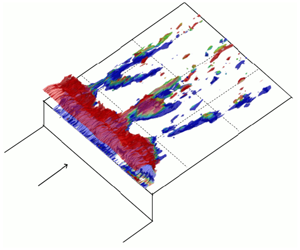Article contents
Mechanisms of stationary cross-flow instability growth and breakdown induced by forward-facing steps
Published online by Cambridge University Press: 11 June 2020
Abstract

An experimental study is performed to determine the mechanisms by which a forward-facing step impacts the growth and breakdown to turbulence of the stationary cross-flow instability. Particle image velocimetry measurements are obtained in the boundary layer of a  $30^{\circ }$ swept flat plate with a pressure body. Step heights range from 53 % to 71 % of the boundary-layer thickness. The critical step height is approximately 60 % of the boundary-layer thickness for the current study, although it is also shown that the critical step height depends on the initial amplitude of the stationary cross-flow vortices. For the critical cases, the stationary cross-flow amplitude grows sharply downstream of the step, decays for a short region and then grows again. The initial growth region is linear, and can be explained primarily through the impact of the step on the mean flow. Namely, the step causes abrupt changes to the mean flow, resulting in large values of wall-normal shear, as well as highly inflectional profiles, due to either cross-flow reversal, separation or both. These inflectional profiles are highly unstable for the stationary cross-flow. Additionally, the reversed flow regions are significantly modulated by the stationary cross-flow vortices. The second region of growth occurs due to the stationary-cross-flow-induced modulation of the shear layer, which leads to multiple smaller wavelength streamwise vortices. High-frequency fluctuations indicate that the unsteady transition mechanism for the critical cases relates to the shedding of vortices downstream of reattachment of the modulated separated regions.
$30^{\circ }$ swept flat plate with a pressure body. Step heights range from 53 % to 71 % of the boundary-layer thickness. The critical step height is approximately 60 % of the boundary-layer thickness for the current study, although it is also shown that the critical step height depends on the initial amplitude of the stationary cross-flow vortices. For the critical cases, the stationary cross-flow amplitude grows sharply downstream of the step, decays for a short region and then grows again. The initial growth region is linear, and can be explained primarily through the impact of the step on the mean flow. Namely, the step causes abrupt changes to the mean flow, resulting in large values of wall-normal shear, as well as highly inflectional profiles, due to either cross-flow reversal, separation or both. These inflectional profiles are highly unstable for the stationary cross-flow. Additionally, the reversed flow regions are significantly modulated by the stationary cross-flow vortices. The second region of growth occurs due to the stationary-cross-flow-induced modulation of the shear layer, which leads to multiple smaller wavelength streamwise vortices. High-frequency fluctuations indicate that the unsteady transition mechanism for the critical cases relates to the shedding of vortices downstream of reattachment of the modulated separated regions.
JFM classification
- Type
- JFM Papers
- Information
- Creative Commons
- As a work owned by the United States Government, this Contribution is not subject to copyright within the United States. Outside of the United States, Cambridge University Press is the non-exclusively licensed publisher of the Contribution.
- Copyright
- © United States Government as Represented by the Administrator of the National Aeronautics and Space Administration outside of the United States of America, 2020
References
- 17
- Cited by


